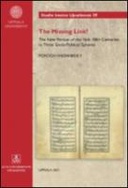Explore

The period of the 16th–18th centuries, when the Safavids were one of the major political powers in the region, is an important era for Persian linguistic evolution. New Persian was the literary language and lingua franca of a vast area stretching from Anatolia to China and the Indo-Pakistan Subcontinent, and from Central Asia to present-day Afghanistan and Iran. The later political separation of post-Safavid Iran from Central Asia and Afghanistan led to the dialectal variations of New Persian. The purpose of this book is to provide a description of the New Persian of the 16th–18th centuries with a focus on a certain set of linguistic parameters. A linguistic description of the New Persian of this period is of great importance, not only for understanding the diachronic processes of language change leading from late Classical New Persian to Modern New Persian, but also for synchronic studies of dialectal variations of the period and the language changes due to language contact. It is also of great importance for further manuscript studies and text edition projects pertaining to this period.
This book is included in DOAB.
Why read this book? Have your say.
You must be logged in to comment.
Rights Information
Are you the author or publisher of this work? If so, you can claim it as yours by registering as an Unglue.it rights holder.Downloads
This work has been downloaded 17 times via unglue.it ebook links.
- 17 - pdf (CC BY-NC-ND) at OAPEN Library.
Keywords
- Dialectial Variations
- Mughal India
- New Persian 16th–18th centuries
- Safavid Iran
- The Khanate of Bukhara
- thema EDItEUR::2 Language qualifiers::2B Indic, East Indo-European and Dravidian languages::2BX Indo-Iranian languages
- thema EDItEUR::C Language and Linguistics
- thema EDItEUR::C Language and Linguistics::CB Language: reference and general::CBX Language: history and general works
- thema EDItEUR::C Language and Linguistics::CF Linguistics::CFP Translation and interpretation
- thema EDItEUR::N History and Archaeology::NH History::NHG Middle Eastern history
- Transitional Period
Links
DOI: 10.33063/6n117r68Editions

